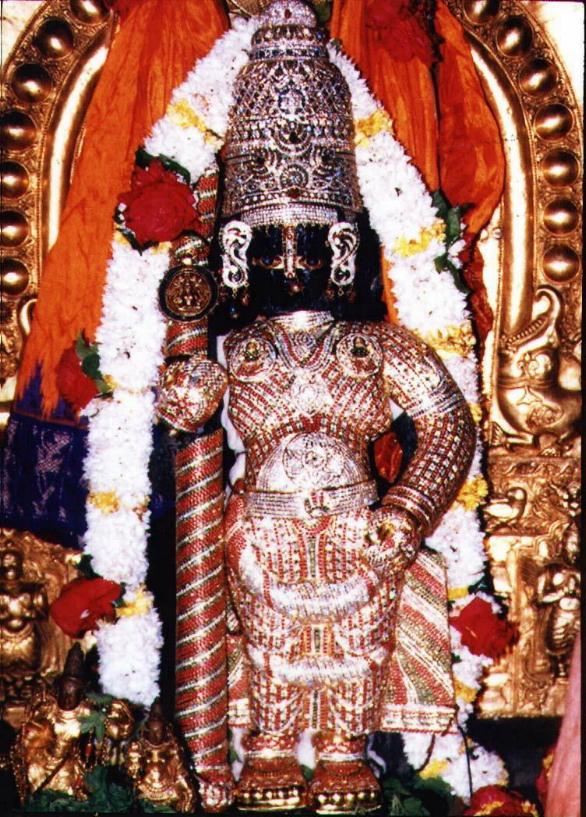Madhya-lila 9.12: […] In the book known as Adhyatma-ramayana, there are statements in Chapters Twelve to Fifteen about the worship of the Deities Sri Ramacandra and Sita. There it is stated that during Lord Ramacandra’s time there was a brahmana who took a vow to fast until he saw Lord Ramacandra.
Sometimes, due to business, Lord Ramacandra was absent from His capital for a full week and could not be seen by citizens during that time. Because of his vow, the brahmana could not take even a drop of water during that week. Later, after eight or nine days, when the brahmana could see Lord Ramacandra personally, he would break his fast.
Upon observing the brahmana’s rigid vow, Lord Sri Ramacandra ordered His younger brother Laksmana to deliver a pair of Sita-Rama Deities to the brahmana. The brahmana received the Deities from Sri Laksmanaji and worshiped Them faithfully as long as he lived.
At the time of his death, he delivered the Deities to Sri Hanumanji, who, for many years, hung Them around his neck and served Them with all devotion. After many years, when Hanumanji departed on the hill known as Gandha-madana, he delivered the Deities to Bhimasena, one of the Pandavas, and Bhimasena brought Them to his palace, where he kept Them very carefully.
The last king of the Pandavas, Ksemakanta, worshiped the Deities in that palace. Later, the same Deities were kept in the custody of the kings of Orissa known as Gajapatis. One of the acaryas, known as Narahari Tirtha, who was in the disciplic succession of Madhvacarya, received these Deities from the King of Orissa.
It may be noted that these particular Deities of Rama and Sita have been worshiped from the time of King Iksvaku. Indeed, they were worshiped by the royal princes even before the appearance of Lord Ramacandra. Later, during Lord Ramacandra’s presence, the Deities were worshiped by Laksmana.
It is said that just three months before his disappearance, Sri Madhvacarya received these Deities and installed them in the Udupi temple. Since then the Deities have been worshiped by the Madhvacarya-sampradaya at that monastery. As far as the Sri Vaisnavas are concerned, beginning with Ramanujacarya, they also worshiped Deities of Sita-Rama.
Sita-Rama Deities are also being worshiped in Tirupati and other places. From the Sri Ramanuja-sampradaya there is another branch known as Ramanandi or Ramat, and the followers of that branch also worship Deities of Sita-Rama very rigidly. The Ramanuja-sampradaya Vaisnavas prefer the worship of Lord Ramacandra to that of Radha-Krishna.
(Cc. Madhya-lila 9: Lord Sri Caitanya Mahaprabhu’s Travels to the Holy Places)
(The Story connected with below Krishna Deity)

Madhya-lila 9.245 […] Once, while sitting beside the sea engrossed in meditation upon Lord Sri Krishna, he saw that a large boat containing goods for Dvaraka was in danger. He gave some signs by which the boat could approach the shore, and it was saved.
The owners of the boat wanted to give him a present, and at the time Madhvacarya agreed to take some gopi-candana. He received a big lump of gopi-candana, and as it was being brought to him, it broke apart and revealed a large Deity of Lord Krishna. The Deity had a stick in one hand and a lump of food in the other. As soon as Madhvacarya received the Deity of Krishna in this way, he composed a prayer.
The Deity was so heavy that not even thirty people could lift it. Madhvacarya personally brought this Deity to Udupi. Madhvacarya had eight disciples, all of whom took sannyasa from him and became directors of his eight monasteries. Worship of the Lord Krishna Deity is still going on at Udupi according to the plans Madhvacarya established.
Most of the information in this purport is available from the South Kanada Manual and the Bombay Gazette.
(Sri Caitanya-caritamrta – 1975 Edition : Cc. Madhya-lila 9.245: Lord Sri Caitanya Mahaprabhu’s Travels to the Holy Places)
(by Damaghosa das)







Speak Your Mind